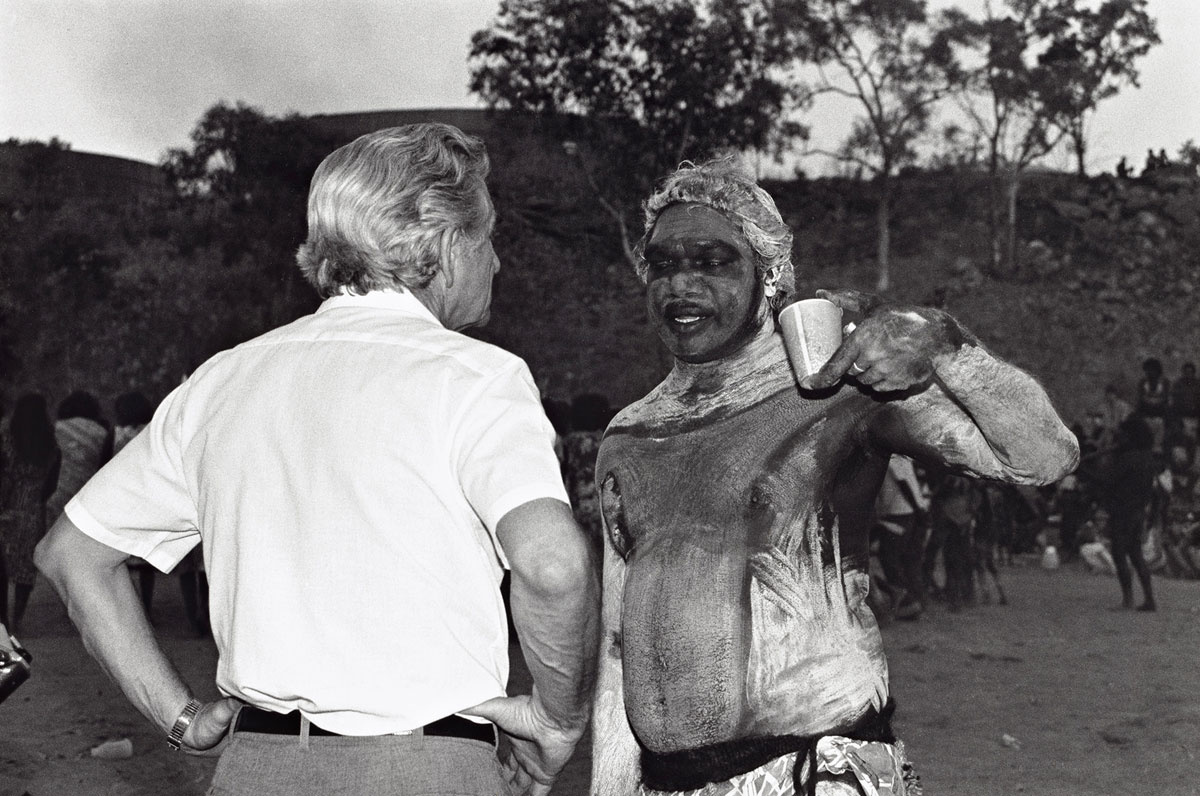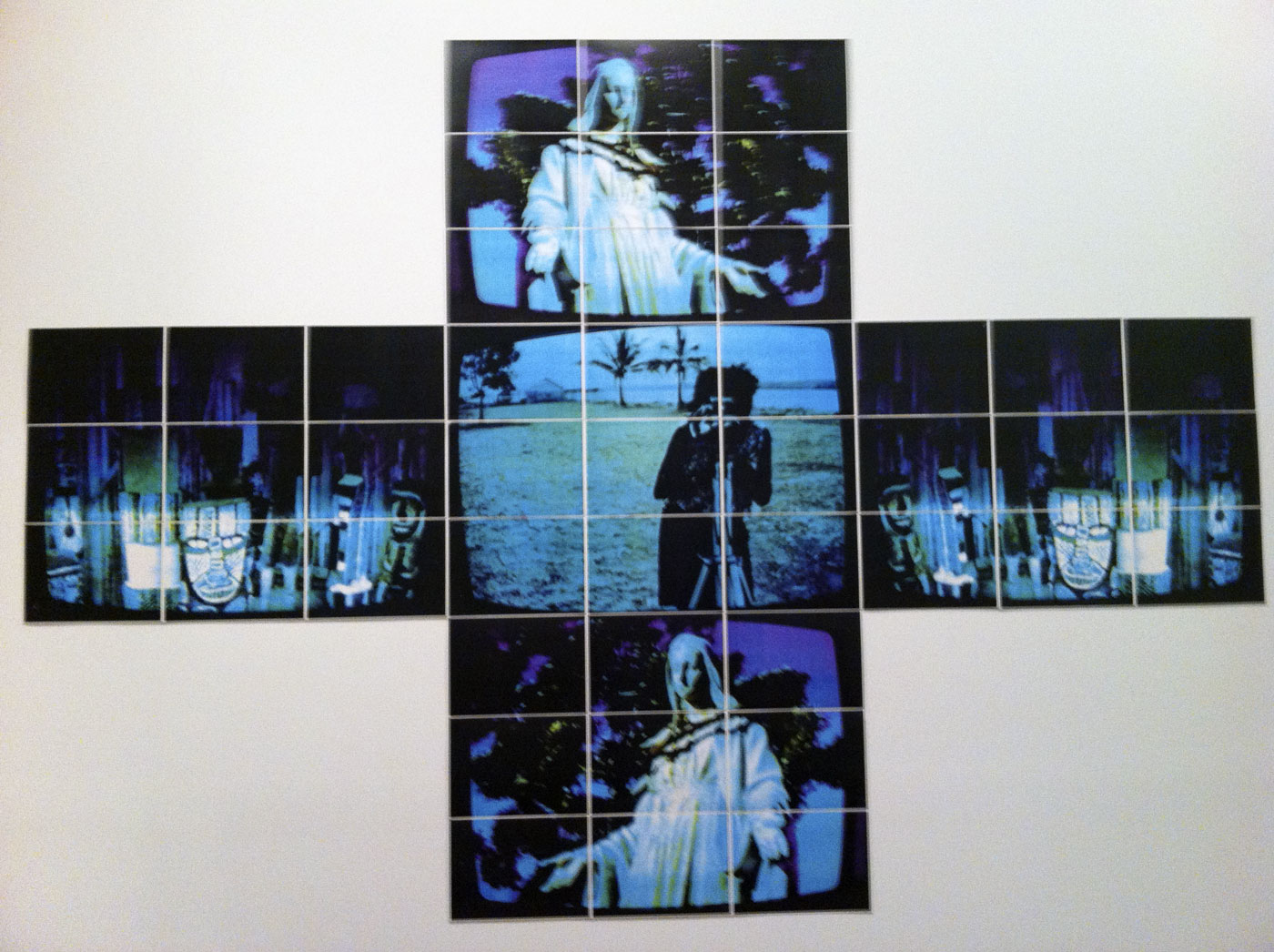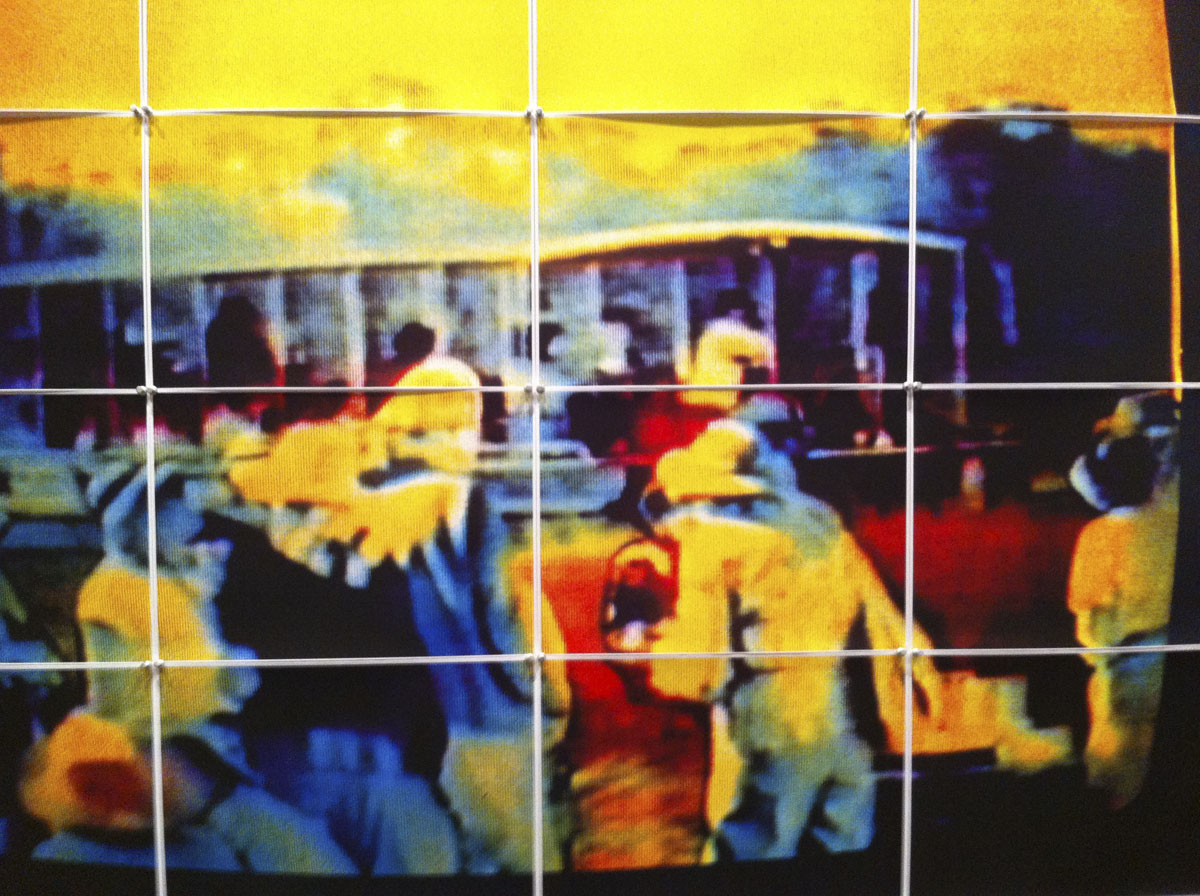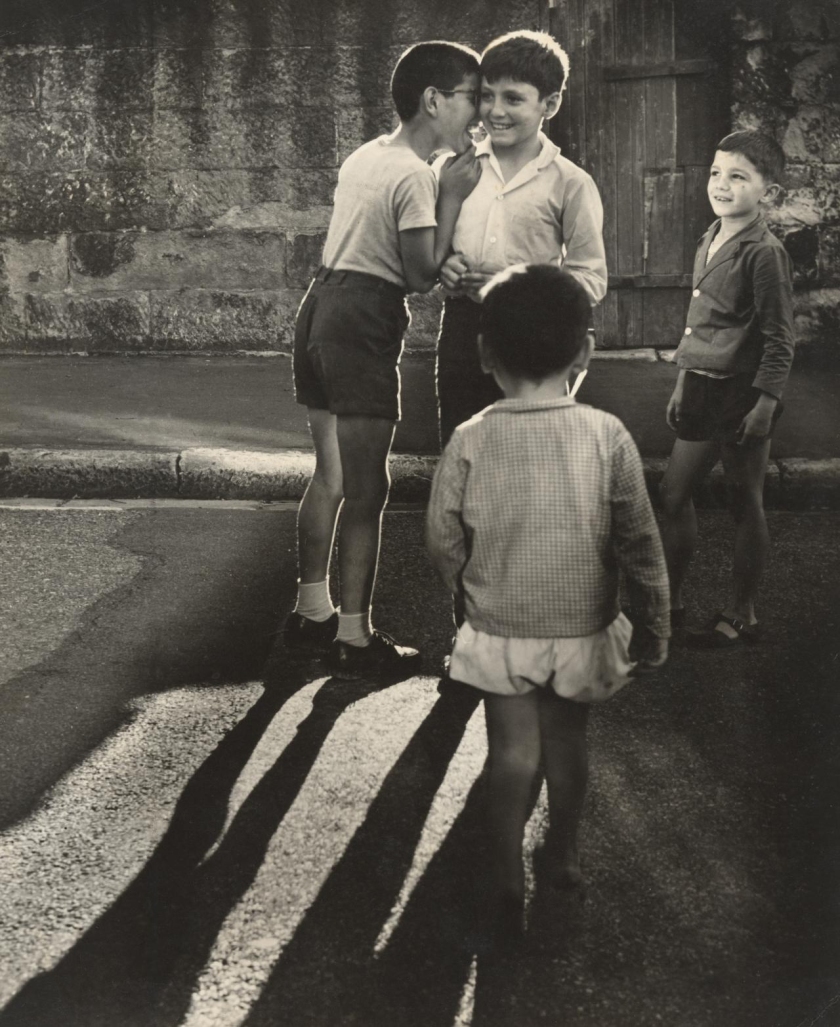Exhibition dates: 17th April – 24th August 2014
Sue Ford (Australia, 1943-2009)
Discussions between Bob Hawke and Galarrwuy Yunupingu
1988, printed 2014
Gelatin silver photograph
51 x 61cm
Sue Ford Archive, Melbourne
© Sue Ford Archive, Melbourne
This is hugely disappointing exhibition of the work of Sue Ford at NGV Australia, Melbourne. The artist deserved better.
There is no doubting the importance of Ford’s early black and white photographs. Images of this type had not been seen in Australia before, and looking back now it is hard to appreciate the impact that the Time series (1962-74), Self-portrait with camera (1960-2006) and images of women had on the photographic scene at the time. These muscular, robust photographs, while not possessing great technical skill, are rightly acknowledged as seminal images in the history of photography in Australia. I cannot praise them highly enough.
However, this exhibition and the important series in it have been ruined by a disastrous hang. The first room is spoiled by an ugly, cheap looking round central installation which is covered by pinned images from the much later series Somewhere in France, 1917 (1995, below) inside of which is projected the video Faces 1976-96 (below). This huge installation simply destroys the sensitivity, size and presence of the small silver gelatin works, overpowering them with repetitive images of a much larger scale.
The second room features a haphazard disposition of Ford’s important portraits of women from her book A Sixtieth of a Second: Portraits of Women 1961-1981, the arrangement of which seems to have no rhyme or reason. It’s all downhill from there. It doesn’t help that Ford’s work looses focus after the initial succinct statements as she begins to work with experimental photographic techniques – photograms, multiple exposures and mirroring of negatives – and, starting in the mid-1980s, branches out into research of Indigenous histories which only results in serviceable photographs at best. What is more disturbing is how later work such as the powerful series Shadow portraits (1994, below) are displayed. I remember seeing this series many years ago at the NGV in St Kilda Road and being bowled over by their size and formal presence; here in a darkened room they are displayed piecemeal and all impact and import is lost. The whole room should have been dedicated to this series, surrounding you with scans of nineteenth-century cartes-de-visite, the empty silhouettes filled with magical photograms of indigenous Australian fauna. That would have been something.
Finally, the exhibition shows 1990s works such as Bima, Brenda and the Madonna (1992-93), Video land (Kakadu river tour) (1994) and Yellowcake (1991) which continue Ford’s interest in social and political issues relating to the Australian landscape. Featuring still images of video shot from a tv screen these fractured, distorted and oversaturated images are printed as colour photocopies and then displayed as fragmented images in a rigid grid system pinned to the wall. These are ugly works. They contain too many elements, the colour, distortion, and bounding box of the tv screen playing badly against the too rigid grid system of the colour photocopies. Ford’s work seems to tail off into something unnatural, a dissolution of identity that really has nothing constructive to say. Perhaps these works do parallel the physical, ecological and spiritual gulf that Ford felt existed between many non-indigenous urban Australians but I don’t really feel that connection in the work and her investigation doesn’t lead to good art. If you want to see the most excellent use of colour, collage, montage, weaving and layering you only have to go up a level at NGV Australia to look at the David McDairmid exhibition to see how it should be done… it’s like night and day, one artist experimenting for abstraction’s sake, and the other really knowing their medium, what they are doing and what narrative / message they want to communicate.
What we cannot take away from Sue Ford is the utmost importance of those feminist images of strong, independent women and the precious, jewel-like, time travelling portrait works. For Ford the process of taking, looking at and using photographs was implicitly connected to a sense of time, time in flux in which the faces of a doubled past (1962-74, 1976-96) are reanimated in the present allowing for a consideration of the effects of ageing and change. Ultimately, these are conceptual works that have great power and integrity.
Unfortunately, the itsy bitsy design of this exhibition doesn’t allow any of the work to shine. It is not up to scratch and not worthy of the artist. Did the NGV run out of time, money and inspiration or where there other factors going on behind the scenes, such as access to the work? I don’t know the answers to these questions, but when you put this exhibition side by side with the 2011 Time Machine: Sue Ford at the Monash Gallery of Art, there is no comparison as to which better conveys the importance of Ford’s work in the history of Australian photography.
Dr Marcus Bunyan
Many thankx to the National Gallery of Victoria for allowing me to publish the photographs in the posting. Please click on the photographs for a larger version of the image.
For some time I have been thinking about the camera itself. Trying to explore its particular UNIQUENESS, coming to terms with the fact that I had been trying to ignore for some years, that the camera is actually a MACHINE. The machine has an enormous power easily abused. Man seems to misuse his machines continuously, with disastrous results for this century. In Time series I tried to use the camera as objectively as possible. It was a time machine. For me it was an amazing experience. It wasn’t until I placed the photograph of the younger face beside the recent photograph that I could fully appreciate the change. The camera showed me with absolute clarity something I could only just perceive with my naked eye.
Sue Ford 1974
Sue Ford (Australia 1943-2009)
Ross, 1964; Ross, 1974
1964-1974, printed 1974
From the Time series 1962-1974
Gelatin silver photograph
(a-b) 11.1 x 20.1cm
National Gallery of Victoria, Melbourne
Purchased with the assistance of the Visual Arts Board and the KODAK (Australasia) PTY LTD Fund, 1974 (PH171.a-b-1974)
© Sue Ford Archive, Melbourne
Sue Ford (Australia, 1943-2009)
Annette, 1962; Annette, 1974
1962-1974, printed 1974
From the Time series 1962-1974
Gelatin silver photograph
11.1 x 20.1cm
National Gallery of Victoria, Melbourne Purchased with the assistance of the Visual Arts Board and the KODAK (Australasia) Pty Ltd Fund, 1974 (PH170.a-b-1974)
© Sue Ford Archive, Melbourne
Sue Ford (Australia, 1943-2009)
No title (Photogram of two hands and garden path)
c. 1970
Gelatin silver photogram
27.6 x 34.7cm irreg. (image and sheet)
National Gallery of Victoria, Melbourne
Gerstl Bequest, 2000
© Sue Ford Archive, Melbourne
Sue Ford (Australia, 1943-2009)
Vietnam: the six o’clock news
c. 1970
Collage of cut gelatin silver photograph on offset-photo lithograph
19.1 x 24.3cm (image and sheet)
Sue Ford Archive, Melbourne
© Sue Ford Archive, Melbourne
Sue Ford (Australia 1943-2009)
Lyn and Carol
1961, printed 1988
Gelatin silver photograph
34.1 x 34.2cm
Art Gallery of New South Wales, Sydney
Purchased 1988 (372.1988)
© Sue Ford Archive, Melbourne
“The ground-breaking work of Australian photographer and filmmaker Sue Ford will be explored in a major retrospective opening at the National Gallery of Victoria on 17 April. One of the most important practitioners to emerge in the wave of 1970s feminist photographers, Ford is recognised for her inventive and unique approaches to the medium and passionate engagement with feminism and gender issues, contemporary politics and the histories of Australia and its Indigenous people.
The exhibition will bring together more than 150 photographs, digital prints, collages and films spanning the five decades of Ford’s career, as well as important archival materials and, poignantly, several unseen works that the artist was working on at the time of her death in 2009.
Tony Ellwood, Director, NGV, said, “Sue Ford has a long and significant history with the National Gallery of Victoria; she was the first Australian photographer to hold a solo exhibition at the Gallery with her renowned Time Series in 1974, and we have been honoured to present her work many times since. It is appropriate, then, that the NGV presents this retrospective exhibition surveying and celebrating her artistic work and life.”
Ford’s Time Series 1962-1974 is regarded as a key moment in Australian photography. In this work, black-and-white double portraits of Ford’s friends and associates were taken around ten years apart and displayed side by side. Some sitters were photographed for a third and even fourth time, producing a remarkable dialogue on the passage of time, identity and personal histories. The entirety of the Time Series will be on display in the exhibition, along with Ford’s long-term project Self-portrait with camera, an extraordinary series of 47 self-portraits taken between 1960 and 2006.
The exhibition will feature Ford’s social documentary and portraiture work; both political and personal, these images reveal intimate depictions of life in inner-city Melbourne along with powerful records of critical political and social milestones including the 1988 Barunga Festival in the Northern Territory. Her prolific output also allows for the exhibition to survey the development of her experimentation with photographic, film, printing and multimedia techniques since the 1960s, such as the photogram, multiple exposures and mirroring of negatives.”
Press release from the NGV website
Sue Ford (Australia, 1943-2009)
Somewhere in France, 1917
1999
Digital plan prints on paper
(1-54) 219.6 x 901.8cm (overall) (installation)
National Gallery of Victoria, Melbourne
Purchased, 1999 (1999.96.1-54)
© Sue Ford Archive, Melbourne
Sue Ford (Australia 1943-2009)
Shadow portraits
1994
Colour photocopies (a-bbbb)
166.5 x 594.0cm
National Gallery of Victoria, Melbourne
Purchased, 1995 (1995.614.a-bbbb)
© Sue Ford Archive, Melbourne
Sue Ford (Australia 1943-2009)
Jim, 1964; Jim, 1969; Jim 1974; Jim 1979
1964-1979, printed 2014
From the Time series II 1962-1982
Gelatin silver photographs
(a-d) 11.1 x 8.2cm (each)
Sue Ford Archive, Melbourne
© Sue Ford Archive, Melbourne
Sue Ford (Australia 1943-2009)
Fabian, 1966; Fabian, 1974; Fabian, 1980
1966-1980, printed 1982
From the Time series II 1962-1982
Gelatin silver photographs
(a) 11.0 x 7.6 cm, (b) 11.8 x 8.4 cm, (c) 11.3 x 8.2cm
Art Gallery of New South Wales, Sydney
Purchased with funds provided by the Art Gallery Society of New South Wales Contempo Group 2013 (265.1996)
© Sue Ford Archive, Melbourne
Sue Ford (Australia 1943-2009)
Self-portrait 1961
1961, printed 2011
Type C photograph
26.0 x 19.9cm
Sue Ford Archive, Melbourne
© Sue Ford Archive, Melbourne
Sue Ford (Australia 1943-2009)
Self-portrait 1974
1974, printed 2011
Selenium-toned gelatin silver photograph
19.9 x 18.0cm
Sue Ford Archive, Melbourne
© Sue Ford Archive, Melbourne
Sue Ford (Australia 1943-2009)
Self-portrait 1986
1986
Gelatin silver photograph
8.4 x 6.5cm
Sue Ford Archive, Melbourne
© Sue Ford Archive, Melbourne
Sue Ford (Australia 1943-2009)
Dissolution
2007
From the Last Light series 2007
Colour lightjet print
112.0 x 142.0cm
Sue Ford Archive, Melbourne
© Sue Ford Archive, Melbourne
Sue Ford (Australia 1943-2009)
Bima, Brenda and the Madonna
1992-1993
Colour laser prints
Sue Ford Archive, Melbourne
Sue Ford (Australia 1943-2009)
Video land (Kakadu river tour) (detail)
1992-1993
Colour laser prints
Sue Ford Archive, Melbourne
The Ian Potter Centre: NGV Australia
Federation Square
Corner of Russell and
Flinders Streets, Melbourne
Opening hours:
Daily 10am – 5pm




























You must be logged in to post a comment.